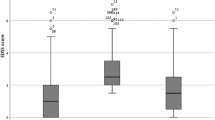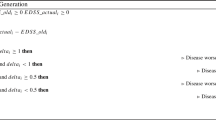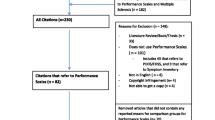Abstract
Background
In relapsing–remitting multiple sclerosis (RRMS), relapse severity and residual disability are difficult to predict. Nevertheless, this information is crucial both for guiding relapse treatment strategies and for informing patients.
Objective
We, therefore, developed and validated a clinical-based model for predicting the risk of residual disability at 6 months post-relapse in MS.
Methods
We used the data of 186 patients with RRMS collected during the COPOUSEP multicentre trial. The outcome was an increase of ≥ 1 EDSS point 6 months post-relapse treatment. We used logistic regression with LASSO penalization to construct the model, and bootstrap cross-validation to internally validate it. The model was externally validated with an independent retrospective French single-centre cohort of 175 patients.
Results
The predictive factors contained in the model were age > 40 years, shorter disease duration, EDSS increase ≥ 1.5 points at time of relapse, EDSS = 0 before relapse, proprioceptive ataxia, and absence of subjective sensory disorders. Discriminative accuracy was acceptable in both the internal (AUC 0.82, 95% CI [0.73, 0.91]) and external (AUC 0.71, 95% CI [0.62, 0.80]) validations.
Conclusion
The predictive model we developed should prove useful for adapting therapeutic strategy of relapse and follow-up to individual patients.




Similar content being viewed by others
References
Confavreux C, Vukusic S, Adeleine P (2003) Early clinical predictors and progression of irreversible disability in multiple sclerosis: an amnesic process. Brain J Neurol 126(Pt 4):770–782
Pittock SJ, McClelland RL, Mayr WT, Jorgensen NW, Weinshenker BG, Noseworthy J et al (2004) Clinical implications of benign multiple sclerosis: a 20-year population-based follow-up study. Ann Neurol 56:303–306
Cossburn M, Ingram G, Hirst C, Ben-Shlomo Y, Pickersgill TP, Robertson NP (2012) Age at onset as a determinant of presenting phenotype and initial relapse recovery in multiple sclerosis. Mult Scler 18(1):45–54
Conway BL, Zeydan B, Uygunoğlu U, Novotna M, Siva A, Pittock SJ et al (2019) Age is a critical determinant in recovery from multiple sclerosis relapses. Mult Scler 25(13):1754–1763
Hirst CL, Ingram G, Pickersgill TP, Robertson NP (2012) Temporal evolution of remission following multiple sclerosis relapse and predictors of outcome. Mult Scler 18(8):1152–1158
Leone MA, Bonissoni S, Collimedaglia L, Tesser F, Calzoni S, Stecco A et al (2008) Factors predicting incomplete recovery from relapses in multiple sclerosis: a prospective study. Mult Scler 14(4):485–493
Kalincik T, Buzzard K, Jokubaitis V, Trojano M, Duquette P, Izquierdo G et al (2014) Risk of relapse phenotype recurrence in multiple sclerosis. Mult Scler 20(11):1511–1522
Langer-Gould A, Popat RA, Huang SM, Cobb K, Fontoura P, Gould MK et al (2006) Clinical and demographic predictors of long-term disability in patients with relapsing–remitting multiple sclerosis: a systematic review. Arch Neurol 63(12):1686–1691
Kalincik T (2015) Multiple sclerosis relapses: epidemiology, outcomes and management. A systematic review. Neuroepidemiology 44(4):199–214
Stewart T, Spelman T, Havrdova E, Horakova D, Trojano M, Izquierdo G et al (2017) Contribution of different relapse phenotypes to disability in multiple sclerosis. Mult Scler 23(2):266–276
Le Page E, Veillard D, Laplaud DA, Hamonic S, Wardi R, Lebrun C et al (2015) Oral versus intravenous high-dose methylprednisolone for treatment of relapses in patients with multiple sclerosis (COPOUSEP): a randomised, controlled, double-blind, non-inferiority trial. Lancet 386(9997):974–981
Polman CH, Reingold SC, Edan G, Filippi M, Hartung H-P, Kappos L et al (2005) Diagnostic criteria for multiple sclerosis: 2005 revisions to the ‘McDonald Criteria’. Ann Neurol 58(6):840–846
Tibshirani R (1996) Regression shrinkage and selection via the Lasso. J R Stat Soc Ser B Methodol 58(1):267–288
Greenland S, Senn SJ, Rothman KJ, Carlin JB, Poole C, Goodman SN et al (2016) Statistical tests, P values, confidence intervals, and power: a guide to misinterpretations. Eur J Epidemiol 31(4):337–350
Heinze G, Wallisch C, Dunkler D (2018) Variable selection—a review and recommendations for the practicing statistician. Biometr J 60(3):431–449
Kyung M et al (2010) Penalized regression, standard errors, and Bayesian lassos. Bayesian Anal 5(2):369–411
R Core Team (2014) R: a language and environment for statistical computing. R Foundation for Statistical Computing, Vienna
Goeman J (2010) L1 Penalized estimation in the Cox proportional hazards model. Biometr J 52(1):70–84
Foucher Y, Danger R (2012) Time dependent ROC curves for the estimation of true prognostic capacity of microarray data. Stat Appl Genet Mol Biol 11(6):1
Milligan NM, Newcombe R, Compston DA (1987) A double-blind controlled trial of high dose methylprednisolone in patients with multiple sclerosis: 1. Clinical effects. J Neurol Neurosurg Psychiatry 50(5):511–516
Berkovich R (2013) Treatment of acute relapses in multiple sclerosis. Neurother J Am Soc Exp Neurother 10(1):97–105
Oliveri RL, Valentino P, Russo C, Sibilia G, Aguglia U, Bono F et al (1998) Randomized trial comparing two different high doses of methylprednisolone in MS: a clinical and MRI study. Neurology 50(6):1833–1836
Trebst C, Reising A, Kielstein JT, Hafer C, Stangel M (2009) Plasma exchange therapy in steroid-unresponsive relapses in patients with multiple sclerosis. Blood Purif 28(2):108–115
Ehler J, Koball S, Sauer M, Mitzner S, Hickstein H, Benecke R et al (2015) Response to therapeutic plasma exchange as a rescue treatment in clinically isolated syndromes and acute worsening of multiple sclerosis: a retrospective analysis of 90 patients. PLoS ONE 10(8):e0134583
Weinshenker BG, O’Brien PC, Petterson TM, Noseworthy JH, Lucchinetti CF, Dodick DW et al (1999) A randomized trial of plasma exchange in acute central nervous system inflammatory demyelinating disease. Ann Neurol 46(6):878–886
Brochet B, Deloire M, Germain C, Ouallet J-C, Wittkop L, Dulau C et al (2020) Double-blind, randomized controlled trial of therapeutic plasma exchanges vs sham exchanges in moderate-to-severe relapses of multiple sclerosis. J Clin Apheresis 35(4):21–289
Deschamps R, Gueguen A, Parquet N, Saheb S, Driss F, Mesnil M et al (2016) Plasma exchange response in 34 patients with severe optic neuritis. J Neurol 263(5):883–887
Faissner S, Nikolayczik J, Chan A, Hellwig K, Gold R, Yoon M-S et al (2016) Plasmapheresis and immunoadsorption in patients with steroid refractory multiple sclerosis relapses. J Neurol 263(6):1092–1098
Cortese I, Chaudhry V, So YT, Cantor F, Cornblath DR, Rae-Grant A (2011) Evidence-based guideline update: plasmapheresis in neurologic disorders: report of the Therapeutics and Technology Assessment Subcommittee of the American Academy of Neurology. Neurology 76(3):294–300
Sellebjerg F, Barnes D, Filippini G, Midgard R, Montalban X, Rieckmann P et al (2005) EFNS guideline on treatment of multiple sclerosis relapses: report of an EFNS task force on treatment of multiple sclerosis relapses. Eur J Neurol 12(12):939–946
Amato MP, Ponziani G, Bartolozzi ML, Siracusa G (1999) A prospective study on the natural history of multiple sclerosis: clues to the conduct and interpretation of clinical trials. J Neurol Sci 168(2):96–106
Myhr KM, Riise T, Vedeler C, Nortvedt MW, Grønning R, Midgard R et al (2001) Disability and prognosis in multiple sclerosis: demographic and clinical variables important for the ability to walk and awarding of disability pension. Mult Scler 7(1):59–65
Arrambide G, Rovira A, Sastre-Garriga J, Tur C, Castilló J, Río J et al (2018) Spinal cord lesions: a modest contributor to diagnosis in clinically isolated syndromes but a relevant prognostic factor. Mult Scler 24(3):301–312
Mowry EM, Pesic M, Grimes B, Deen S, Bacchetti P, Waubant E (2009) Demyelinating events in early multiple sclerosis have inherent severity and recovery. Neurology 72(7):602–608
Kragt JJ, Thompson AJ, Montalban X, Tintoré M, Río J, Polman CH et al (2008) Responsiveness and predictive value of EDSS and MSFC in primary progressive MS. Neurology 70(13 Pt 2):1084–1091
Hirst C, Ingram G, Pearson O, Pickersgill T, Scolding N, Robertson N (2008) Contribution of relapses to disability in multiple sclerosis. J Neurol 255(2):280–287
Eriksson M, Andersen O, Runmarker B (2003) Long-term follow up of patients with clinically isolated syndromes, relapsing–remitting and secondary progressive multiple sclerosis. Mult Scler 9(3):260–274
Author information
Authors and Affiliations
Corresponding author
Ethics declarations
Conflicts of interest
F. Lejeune reports no disclosures. A. Chatton reports no disclosures. D.-A. Laplaud reports personal fees and non-financial support from Biogen, Merck, Novartis, Genzyme, Teva, Roche and MedDay, all outside the submitted work. S. Wiertlewski received consultancy fees, speaker fees, honoraria and clinical research grants from Biogen-Idec, Merck, Novartis, Genzyme, Roche, Sanofi-Aventis and Teva, all outside the submitted work. G. Edan reports no disclosures. E. Le Page has received grants, personal fees and non-financial support from Biogen Idec, Genzyme, Merck-Serono, Novartis, Roche, Sanofi and Teva, all outside the submitted work. A. Kerbrat reports no disclosures. D. Veillard reports no disclosures. S. Hamonic reports no disclosures. N. Jousset reports no disclosures. F. Le Frère reports no disclosures. J.-C. Ouallet reports personal fees from Biogen, Roche and Genzyme, and grants, personal fees and non-financial support from Novartis and Merck, all outside the submitted work. B. Brochet reports grants from the French Ministry of Health, personal fees and non-financial support from Biogen-Idec, grants from Merck-Serono, personal fees and non-financial support from Novartis, personal fees and non-financial support from Genzyme, grants, personal fees and non-financial support from Teva, and grants and non-financial support from Bayer, all outside the submitted work. A. Ruet has received consultancy fees, speaker fees, research grants (non-personal) or honoraria from Medday, Novartis, Biogen Idec, Genzyme, Roche, Teva, and Merck, all outside the submitted work. Y. Foucher has received speaking honoraria from Biogen and Sanofi-Genzyme. L. Michel has received grants and fees from Biogen Idec, Merck Serono, Roche, Sanofi Genzyme, Teva and Novartis, all outside the submitted work.
Ethics approval
Data confidentiality and safety were ensured in accordance with the recommendations of the French National Ethics Committee (CNIL-Commission Nationale Informatique et Libertés), which provided approval for the EDMUS database. All data identifying patients were anonymised. All human studies were performed in accordance with the ethical standards laid down in the 1964 Declaration of Helsinki and its later amendments. Specific national laws were also observed.
Rights and permissions
About this article
Cite this article
Lejeune, F., Chatton, A., Laplaud, DA. et al. SMILE: a predictive model for Scoring the severity of relapses in MultIple scLErosis. J Neurol 268, 669–679 (2021). https://doi.org/10.1007/s00415-020-10154-5
Received:
Revised:
Accepted:
Published:
Issue Date:
DOI: https://doi.org/10.1007/s00415-020-10154-5




